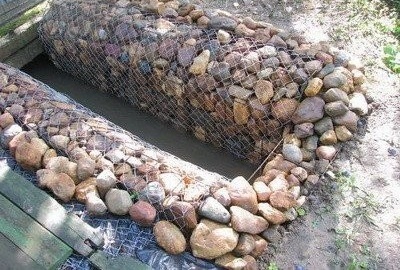Overview of the 5 best ways to strengthen the walls of the drainage ditches
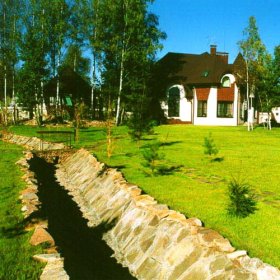
The plot on which the house is built most often needs a drainage system. This is a rather complicated and by no means cheap design. The most expensive option is laying a closed system, so many choose an open system. It consists of several drainage ditches, interconnected. The main problem with this design is the gradual shedding of slopes, which, over time, "move" to the bottom. There are many ways to strengthen the walls of drainage ditches. Let's consider them in more detail.
Choosing a way to strengthen the slopes of the ditch, you should be guided, first of all, by the angle of inclination of its walls:
- Slopes with an inclination angle of less than 8 ° do not need to be strengthened. Planting of plants of vertical and horizontal action will be enough for them.
- Walls, the steepness of which varies from 8 to 15 °, must be reinforced with geogrids or geomats.
- Slopes of significant steepness with an inclination angle of more than 15 ° should be strengthened by methods involving internal reinforcement. Gabions and geogrids are well suited for these purposes.
In addition to the angle of inclination of the wall, the depth of the ditch is of great importance. If it is small, you can strengthen the slopes by hammering stones in them.
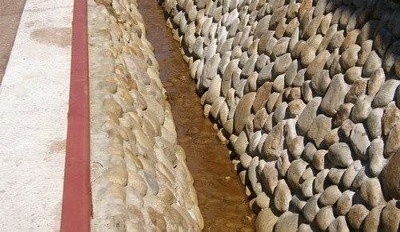
The slopes of the drainage ditches need to be strengthened. If their depth is small, you can strengthen the slopes by hammering stones in them
Content
Option # 1 - three-dimensional geogrid
A geogrid is widely used for reinforcing slopes. It is produced from polymer fibers with reinforced monofilament interlaced structure and stitched cell nodes. To increase the strength, the material is additionally impregnated with polymer compositions. The root system of plants easily penetrates through the cellular coating and forms a sod layer, which allows you to reliably fix the earthen cover on the slope, strengthens the slopes and increases their stability.
The geogrid is laid as follows:
- We align and compact the walls of the ditch with a hand roller.
- We lay the material rolls along the trench at a distance that corresponds to the width of the panel.
- Roll out the grid, laying the strip almost end-to-end.
- We fix the laid material every meter and a half with anchors with bent upper ends. If strong winds are frequent in this area, then U-shaped metal staples are best used as fasteners.
- We fix the fixed geogrids with soil or decorative material. It can be a stone, crushed stone, etc. Suitable plants are sown on top of the soil.
The erosion control geogrid is resistant to decay, corrosion, high and low temperatures.The material is not afraid of aggressive environments, withstands high stresses and is not deformed. Over time, its operational characteristics do not change. The geogrid restricts slope deformation and soil movement. The material becomes the basis for a solid mass that can withstand heavy loads. Including frosty heaving, subsidence and soil displacement. Flexible coating can be used on surfaces of any configuration.
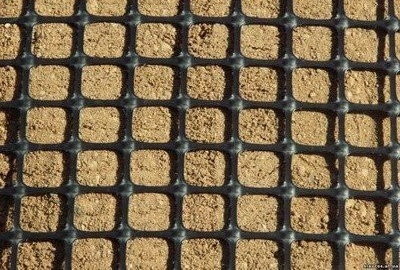
The geogrid restricts slope deformation and ground movement. It is durable, resistant to aggressive environments and rotting.
Option # 2 - anti-erosion geomats
Geomats are structures formed by three layers of polypropylene double orientation lattices. The nets are superimposed on each other and fastened together by a polypropylene thread. The structure of the resulting product resembles a washcloth, which allows it to fix the soil and not interfere with the growth of plants. Over time, the roots of vegetation entwine around the lattices of geomats, which makes their structure even more durable.
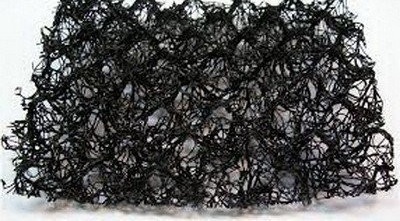
The geomat has a porous structure that allows the root system of plants to easily pass through the material
Material Properties:
- resistance to UV radiation;
- full preservation of its properties in sea and fresh water;
- resistance to aggressive environments;
- non toxicity;
- resistance to a wide range of temperatures;
- low level of smoke formation and flammability;
- resistance to microorganisms.
Using geomats allows you to preserve the natural look and nature of the landscape. The material is quite simple to install and, if necessary, can be laid even in winter. The process of strengthening the slopes is carried out in several stages:
- We level and clear the walls of the ditch from debris.
- We fix the upper edge of the first roll with anchor bolts in the upper part of the slope.
- Roll the roll to the bottom and cut the desired length fragment.
- We carefully expand the material and fix its lower part.
- We lay the next coating strip on the first with an overlap of about 15 cm.
A layer of soil 3-5 cm high is poured over the laid geomats, into which the seeds of the plants are sown. Professionals recommend using such a sowing scheme. Sow two-thirds of the seeds on the open surface of the material, and a third on sowed soil. Seed consumption is about 40 g per square. meter.
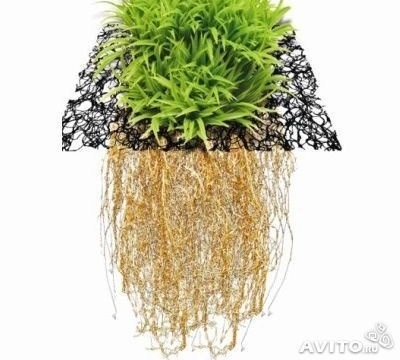
After laying the geomats and backfilling them with soil, you need to sow plants whose root system will strengthen the slopes of the trench
Option # 3 - homemade gabions
Gabions are a frame made of a metal mesh with cells in the form of a hexagon. The design is filled with crushed stone, pebbles or stones. Such a system perfectly protects the slopes from shedding. Gabions are made of double torsion mesh coated with zinc, galvanized or polyvinyl chloride. The contents of the structure are selected so that the filler fraction is smaller than the cell size. To facilitate installation, gabions are first installed, and then filler is poured into them.
Two types of structures are distinguished: mattress-mattress and box-shaped. The former are used for covering surfaces and shaping them. Of the box perform retaining structures. They are used to strengthen the slopes of the trenches. The porous structure of the product provides the necessary drainage properties, eliminates hydrological loads on the walls of the ditch and soil removal from the slope. The manufacturer guarantees a long service life of the structure, it can reach one hundred years. Gabions favorably affect the natural ecosystem, their effectiveness only increases over time.
The disadvantage of factory designs is considered to be their high cost.However, gabions can be made independently, while choosing the most suitable sizes for specific conditions. The work is carried out in several stages:
- We determine the dimensions of the future design. For small areas, it is optimal to choose gabions with dimensions of 800 * 400 * 400 mm. We select the sizes of the cells, which should be larger than the diameter of the filler. Therefore, the latter should already be acquired.
- From rods with a diameter of 6 mm, we weld the structures of the desired size of a rectangular shape.
- Ready frames are installed on the slopes of the drainage ditch.
- We fill the gabions with a pre-prepared filler.
- Top cover homemade gabion mesh netting. Thus, the design will gain greater strength.
The netting is subject to corrosion. The problem is solved in two ways. You can purchase a mesh with protection, coated with PVC or galvanized. Or, proceed as follows: fix a regular grid so that it can easily be replaced after a while with a new one.
Option # 4 - volumetric geogrid
A geogrid or geocell, geocell is a geosynthetic coating, which is a three-dimensional structure made of tapes that are fastened together. In the process of manufacturing a geogrid, polyethylene tapes are staggered to be welded together. The result is a reliable frame with the same size cells.

Different filler can be poured into the cells of the geogrid. For “wet” ditches, pebbles or crushed stone are preferable; for dry ditches, sand is suitable
Two types of geogrid are produced: with and without perforation. The first is characterized by better drainage ability. It is such material that is recommended to be used to strengthen the walls of drainage trenches. The coating without perforation is allowed to be laid on the slopes only if there is an intermediate layer of geotextiles. Geogrid installation is carried out as follows:
- We level the slopes of the trench, give them the desired shape and compact the soil. If necessary, lay geotextiles on the base.
- We lay the material in the direction from top to bottom.
- We stretch the geogrid and fix it with L-shaped anchors. The life of the structure depends on the correctness of this operation.
- We fill the coating with bulk material. If the recess is filled with water, lay crushed stone, pebbles or any similar filler. For dry trenches, sand is suitable.
Geosots differ in cell size, as well as the height of the ribs. The choice of material depends on the type of bulk material and the steepness of the slope. The product is characterized by good flexibility and high strength. It is resistant to various aggressive environments, does not rot and deteriorate, is non-toxic and has a long service life.
Option # 5 - budget ways
The options described above are quite expensive. If you want to strengthen the walls of the drainage ditch on the principle of "cheap and cheerful", you can use these methods.
Using old tires
This cheap method involves the use of used tires, which in most cases can be obtained for free. Backfill will require ordinary soil or sand. Tires are laid in rows, with each next shifting half the diameter of the tire. The parts are tightly interconnected and reinforced with stakes that clog into the center of each tire. Stacked parts are covered with soil or sand. The gaps between the tires also fall asleep. The design is ready.
Slate reinforcement
An even simpler option involves the use of slate sheets. You can use a flat or wavy material. Sheets are fixed with metal posts. The main advantages of this method can be considered small labor costs and low cost. Unfortunately, such a system will not last too long. However, it performs its function well enough and saves the slopes from slipping.
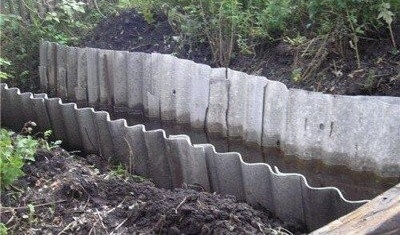
Strengthening the walls of the drainage ditch with slate sheets is one of the most simple, budget options
A drainage system is a necessary attribute of most sites. There are many ways to equip it. The simplest of them is open drainage ditches. Various methods can be chosen to protect the slopes of the trenches from collapse. You can decide on the option only after analyzing specific conditions, including the type of soil, the slope angle of the ditch, and, of course, the financial capabilities of the owner. Experts recommend the use of modern reinforcing materials, which are probably more expensive than "budget funds." But such systems will last a long time and will not cause trouble to the owner.
